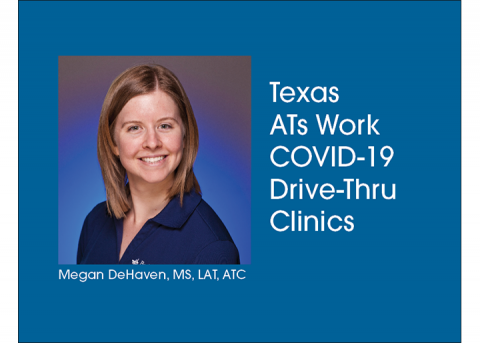
During the COVID-19 pandemic, athletic trainers have stepped up to help their local health care systems in multiple ways, including screening, telemedicine and infrastructure. NATA will share what athletic trainers everywhere are doing to care for their patients, communities and themselves during this time.
In Round Rock, Texas, just about 20 miles outside of Austin, some secondary schools have been put on an extended spring break with all sports being canceled until May with a possible return to practice in mid-April. The athletic trainers at Baylor Scott & White Health who assisted student athletes are no longer serving them.
“As of March 25, our county [in Round Rock] has been put in a shelter-in-place [order],” said Megan DeHaven, MS, LAT, ATC, an athletic trainer with Baylor Scott & White Health. “For my staff, we are not in contact with student athletes, except by electronic communications for those being treated before the extended spring breaks and cancellations. Our contracts are on a pro re nata basis, making us less connected to the school system than we would be on a part-time or full-time basis.”
With the growing number of cases in the area, Baylor Scott & White Health has created drive-thru swab clinics. These new facilities had some roles that needed to be filled, so DeHaven and her athletic training staff have moved in to assist these clinics.
“Currently, I am working with our health care system to coordinate the schedules and communications for all of our drive-thru clinics we have opened and closed,” DeHaven said. “My direct supervisor is overseeing the operations. My athletic training staff are working at the drive-thru clinics as interviewers. A lot of our responsibilities for the sports medicine program have changed as our contracted coverage has been canceled by athletics governing bodies and athletes aren’t participating in organized sport, decreasing our referral volumes to zero.”
Some ATs are working in new situations during COVID-19 to help alleviate their overwhelmed local health care system. DeHaven’s staff are working with personal protective equipment while at the drive-thru clinics, a shift in how they handle daily operations in the athletic training facility, she said.
“They are learning to take care of the patient with a positivity needed in these times, but without the physical interaction we would normally have with evaluations of the musculoskeletal system,” she said. “It’s certainly a different type of patient care, so a lot is being learned in the process.”
DeHaven said she feels now is a chance to show others how imperative ATs are to the health care system as well as demonstrate the AT’s expertise in emergency situations.
“In this time, we can truly show our skills with emergency management by integrating ourselves in this time of need,” DeHaven said. “To show our value in this time will be a huge asset for future representation of our profession.”
Though these are trying and anxious-filled times, DeHaven said she has found a light through the pandemic. With hard work comes high praise, and that’s exactly what her and her staff have been given thanks to their athletic training skills and health care knowledge as they’ve transitioned into these new roles.
“A very positive part of this experience has been the positive feedback from clinic managers who are working with my staff,” she said. “One clinic manager gave them praise for their ability to work fluidly with a team they literally just met and the efficiency of their work. I am proud of my staff and their involvement in our drive-thru clinic efforts. That is the brightest spot for me.”
As cases of COVID-19 spread throughout the world, more drive-thru clinics have the possibility of popping up around the country. Continued support from athletic trainers within overwhelmed health care systems is a way to help the community and medical professionals fighting to end the pandemic. As someone in the hospital setting, DeHaven offers some advice to ATs in all settings.
“I would recommend, if athletic trainers are interested in being a part of drive-thru clinics, to search online for clinics hosted by their cities or counties,” she said. “Those drive-thru clinics are run by their health departments and/or health care organizations. Reaching out to those contacts directly will start a conversation on either paid or volunteer work to keep athletic trainers engaged.”
ATs can also use Go4Ellis, a mobile per-diem job platform, to connect with understaffed hospitals and health care systems in need during the COVID-19 pandemic. While Go4Ellis was originally designed to provide sporting/local events with appropriate health care for youth athletes, it has been modified to support hospital systems and health care organizations in need of COVID-19 support. Learn more on our Call to Action webpage.
If you’d like to learn more about NATA resources, visit our COVID-19 resource page.





